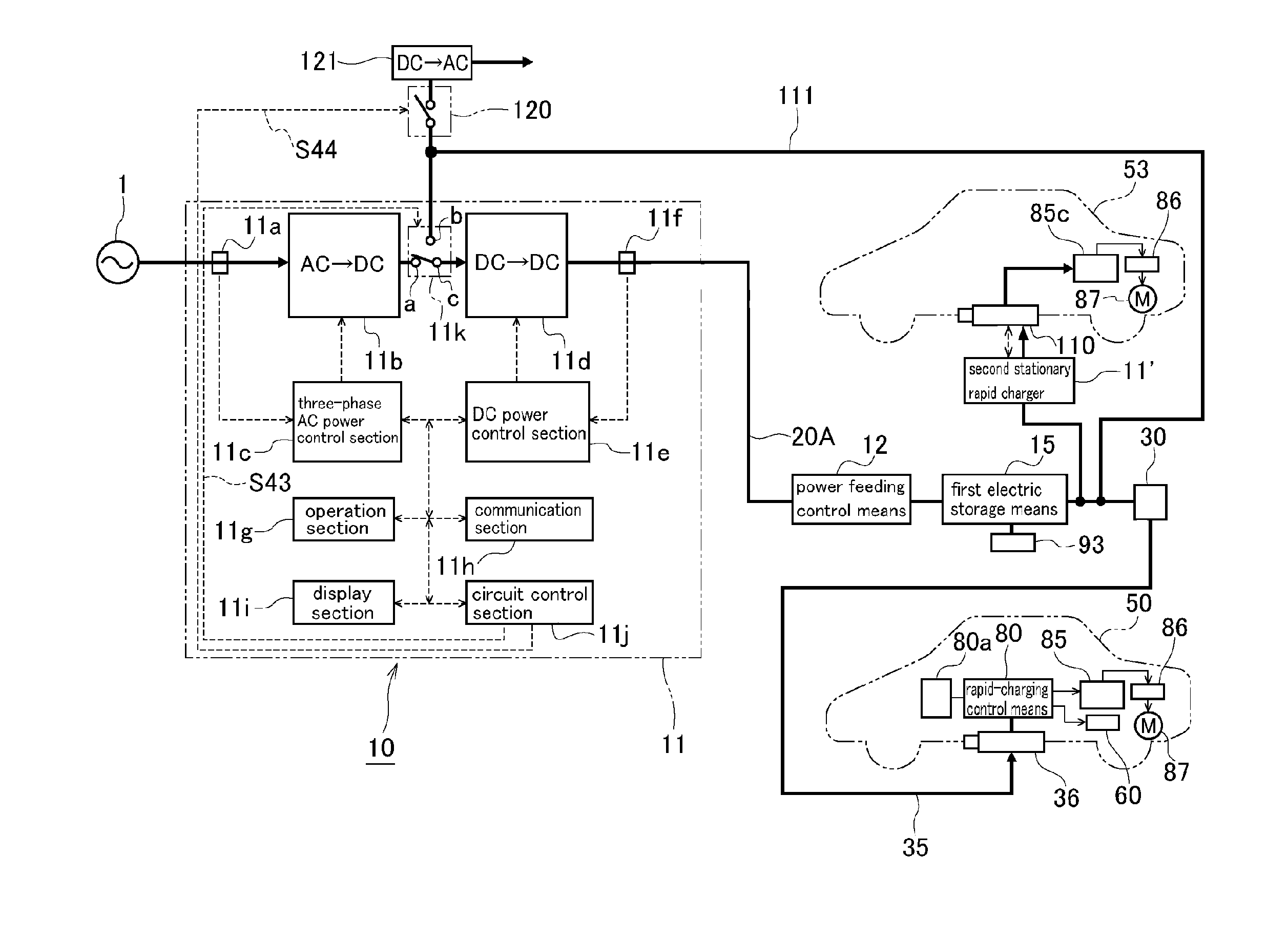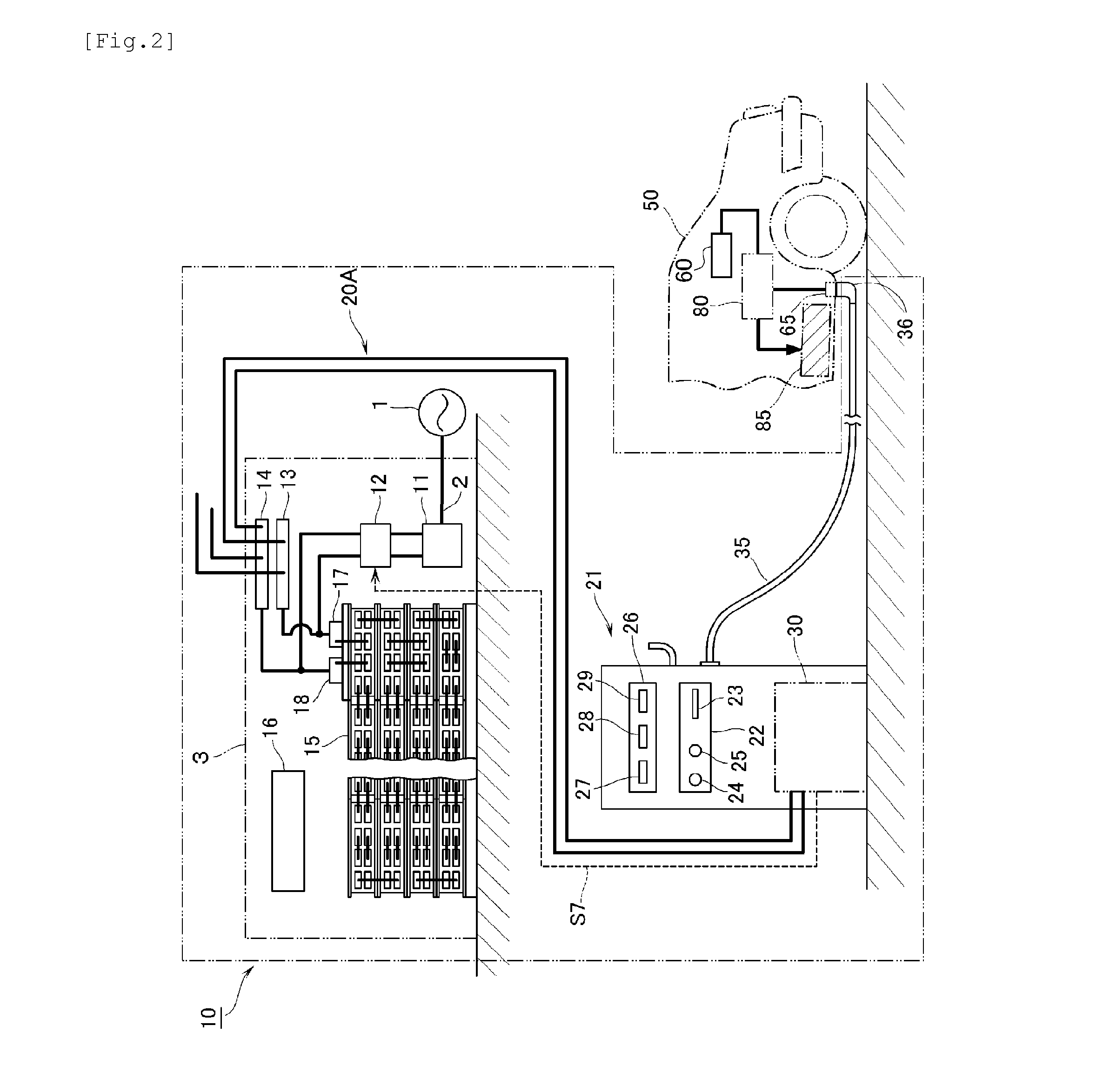Rapid charging power supply system
- Summary
- Abstract
- Description
- Claims
- Application Information
AI Technical Summary
Benefits of technology
Problems solved by technology
Method used
Image
Examples
embodiment 1
[0050]FIGS. 1 to 12 show Embodiment 1 according to the present invention. In FIG. 2, reference numeral 1 indicates a commercial AC power supply as a power source, and a three-phase AC power supply, for example, is used as an AC power supply 1. Power from the AC power supply 1 is supplied into a building 3 through an electric power line 2. Within the building 3, there are a first stationary rapid charger 11, a power feeding control means 12, a first electric storage means 15 functioning as a stationary electric storage means, and other devices, which constitute a rapid charging power supply system 10. The input side of the first stationary rapid charger 11 is connected to the electric power line 2 within the building 3. The first stationary rapid charger 11 has a function of regulating three-phase AC power from the electric power line 2 to a predetermined voltage value, and converting it into DC power. The output side of the first stationary rapid charger 11 is connected to a first e...
embodiment 2
[0090]FIG. 13 shows Embodiment 2 according to the present invention, showing a case of application for rapid charging with electric power obtained by using renewable energy. The difference in Embodiment 2 from Embodiment 1 is the difference in the power supply used for rapid charging, and the remaining parts correspond to Embodiment 1. Accordingly, the same reference numerals as those in Embodiment 1 are denoted for the corresponding parts, thus omitting the description with respect to the corresponding parts. The same applies to other embodiments to be described below.
[0091]Electric power generation utilizing renewable energy such as wind power or solar light is excellent for environment since such generation does not produce CO2 during the generation of electric power. However, such wind power generation and solar power generation are susceptible to weather, and the output is greatly varied, thus having a problem of being difficult to be in cooperation with electric power systems....
embodiment 3
[0093]FIGS. 14 and 15 show Embodiment 3 according to the present invention. The difference in Embodiment 3 from Embodiment 1 is only the presence or absence of a power supply switching means 11m in a first stationary rapid charger 11. In Embodiment 3, with regard to rapid charging of vehicles 53 to 55 as second electric moving bodies with no rapid-charging control means 80 equipped therein, the rapid charging can be performed by using only a first stationary rapid charger 11, without a first electric storage means 15 or a second stationary rapid charger 11′.
[0094]As shown in FIG. 14, the power supply switching means 11m is connected with the output side of the power supply switching means 11m. In Embodiment 3, as shown in FIG. 15, the power supply switching means 11m is integrated with the first stationary rapid charger 11. The power supply switching means 11m is constituted of a first fixed contact point a, a second fixed contact point b, and a moving contact c. The moving contact ...
PUM
 Login to View More
Login to View More Abstract
Description
Claims
Application Information
 Login to View More
Login to View More - R&D
- Intellectual Property
- Life Sciences
- Materials
- Tech Scout
- Unparalleled Data Quality
- Higher Quality Content
- 60% Fewer Hallucinations
Browse by: Latest US Patents, China's latest patents, Technical Efficacy Thesaurus, Application Domain, Technology Topic, Popular Technical Reports.
© 2025 PatSnap. All rights reserved.Legal|Privacy policy|Modern Slavery Act Transparency Statement|Sitemap|About US| Contact US: help@patsnap.com



